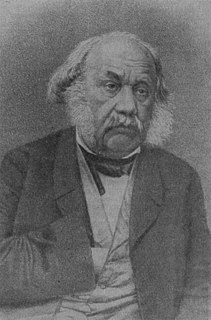
Nikolai Stepanovich Turczaninow was a Russian botanist and plant collector who first identified several genera, and many species, of plants.

Eucalyptus tetraptera, commonly known as square-fruited mallee or four-winged mallee, is a mallee that is endemic to the south coast of Western Australia. It has smooth bark, thick lance-shaped to oblong adult leaves, single flower buds arranged in leaf axils, red to pink flowers and square, prominently winged fruit.

Eucalyptus pyriformis, commonly known as pear-fruited mallee or Dowerin rose, is a species of low, straggly mallee that is endemic to Western Australia. It has smooth greyish brown bark sometimes with ribbony bark near the base, egg-shaped to lance-shaped adult leaves, flower buds in groups of three, red, pinkish or creamy white flowers and down-turned, conical fruit with prominent ribs.
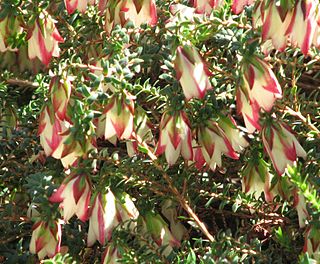
Darwinia macrostegia, commonly known as Mondurup bell, is a shrub which is endemic to a localised area near Albany in Western Australia. It usually grows to between 0.3 and 0.9 metres in height and produces red and white flowers between late autumn and late spring.
Verticordia carinata, commonly known as pea-shaped featherflower or Stirling Range featherflower, is a flowering plant in the myrtle family, Myrtaceae and is endemic to Western Australia. It is an erect, spindly shrub with small, well-spaced leaves and pink and red flowers. It is a rarely seen plant, not known between its description in 1849 and its rediscovery in 1990.
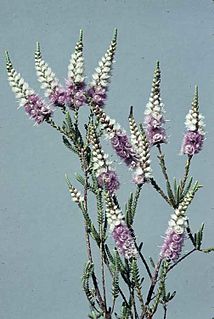
Verticordia spicata, commonly known as spiked featherflower, is a flowering plant in the myrtle family, Myrtaceae and is endemic to the south-west of Western Australia. It is usually a dense, bushy shrub with small leaves pressed against the stem and spikes of pink flowers from late spring to early summer.

Geleznowia is a monotypic genus of plant in family Rutaceae. It was defined by Ukrainian-Russian botanist Nicolai Stepanovitch Turczaninow in 1849. Its only species is Geleznowia verrucosa.

Cyathostemon is a genus of flowering plants in the myrtle family, Myrtaceae. The genus is endemic to southwestern Western Australia. The genus was first described by Nikolai Turczaninow in 1852. Species include:

Lachnostachys is a genus of flowering plants in the mint family, Lamiaceae, first described in 1842 by William Jackson Hooker. The type species is Lachnostachys ferruginea. The genus name, Lachnostachys, comes from two Greek words/roots, lachnề ("wool") and -stachys, and thus describes the genus as having spiked woolly inflorescences. The entire genus is endemic to Western Australia

Eucalyptus uncinata, commonly known as the hook-leaved mallee, is a species of mallee that is endemic to the southwest of Western Australia. It has smooth bark, lance-shaped adult leaves, flower buds arranged in groups of nine to thirteen, creamy white flowers and barrel-shaped to oval or cylindrical fruit.
Platysace commutata is a shrub that is endemic to Western Australia.
Taxandria floribunda is a small tree or shrub species that is endemic to an area in southern Western Australia. This plant was previously classified as Agonis floribunda but is now part of the Taxandria genus.
Hibbertia crassifolia is a shrub in the Dilleniaceae family and is endemic to Western Australia. It is an erect shrub with multiple stems that typically grows to a height of 0.2 to 0.6 m but can reach 0.9 m. It blooms between April and September and produces yellow flowers. The species has a scattered distribution through the western Wheatbelt region of Western Australia between Three Springs in the north, Ballidu in the east and Wandering in the south where it is found on sandplains and breakaways growing in sandy lateritic soils.
Eucalyptus cuspidata is a species of small, spreading mallee that is native to the south-west of Western Australia.
Daviesia obovata is an endangered species in the Fabaceae family, native to the south-west of Western Australia.
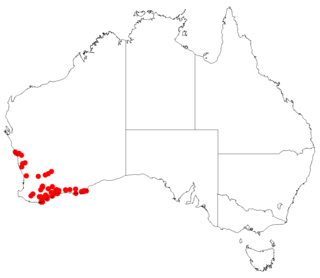
Asteridea asteroides is a herb in the Asteraceae family, which is endemic to Western Australia. It was first described in 1853 by Nikolai Turczaninow as Trichostegia asteroides. In 1980, G. Kroner assigned it to the genus, Asteridea, giving it the name Asteridea asteroides. It is a perennial herb, growing on sand or gravelly sand to heights of from 5 cm to 30 cm. Its white flowers may seen from August to November in Beard's South-West Province.
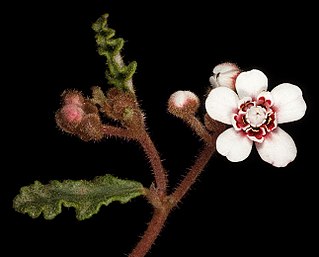
Androcalva pulchella is a shrub in the family Malvaceae. It is native to Western Australia.
Hibbertia drummondii is a shrub in the family Dilleniaceae family and is endemic to Western Australia. It is an erect shrub that typically grows to a height of 0.3–1 m. It flowers from September to October and produces yellow flowers. The species was first described in 1849 by Nikolai Turczaninow in the Bulletin de la Société Impériale des Naturalistes de Moscou and given the name Ochrolasia drummondii. In 1893, Ernest Friedrich Gilg changed the name to Hibbertia drummondii in Die Natürlichen Pflanzenfamilien. The specific epithet (drummondii) honours James Drummond.
Hibbertia helianthemoides is a species of flowering plant in the family Dilleniaceae and is endemic to a small area in the south-west of Western Australia. It is a prostrate to low-lying, spreading to erect, hairy shrub with hairy foliage, linear leaves and yellow flowers with thirteen stamens.
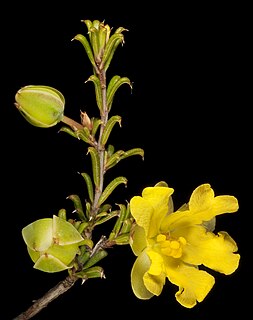
Hibbertia rostellata is a species of flowering plant in the family Dilleniaceae and is endemic to the south-west of Western Australia. It is a low, straggling or erect shrub that typically grows to a height of 15–50 cm (5.9–19.7 in) and flowers between August and November producing yellow flowers. It was first formally described in 1849 by Nikolai Turczaninow in the Bulletin de la Société Impériale des Naturalistes de Moscou. The specific epithet (rostellata) means "possessing a small beak or snout", referring to the tip of leaves.













